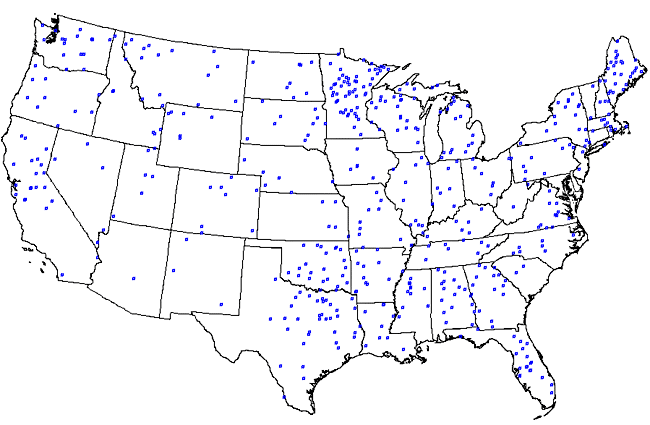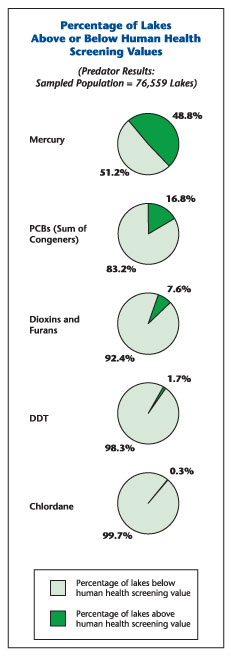National Study of Chemical Residues in Lake Fish Tissue Results
The National Lake Fish Tissue Study is the first national assessment of freshwater fish contamination in the United States for which sampling sites were selected according to a statistical (random) design. To interpret the results, it is essential to understand the following important points about this design:
- During the four-year sampling period, field teams collected 486 predator composites and 395 bottom-dweller composites from the 500 sampling locations. Predator and bottom-dweller species did not occur together at every sampling site; however, if either a predator or bottom-dweller species was present, the target lake was sampled.
- The 486 predator composites and the 395 bottom-dweller composites collected during the study each comprise nationally-representative samples for the lower 48 states whose results can be extrapolated to an estimated 76,559 lakes for predators and an estimated 46,190 lakes for bottom-dwellers.
- The unequal probability design makes it necessary to apply sample weights (derived from the various probabilities assigned to each of the lake size categories) to the fish tissue data to develop national estimates of fillet (predator) and whole-body (bottom-dweller) fish tissue concentrations for each of the 268 target chemicals.
Results from the National Lake Fish Tissue Study indicate that mercury, PCBs, and dioxins and furans are widely distributed in lakes and reservoirs in the lower 48 states. Mercury and PCBs were detected in all the fish samples collected from the 500 sampling sites. Dioxins and furans were detected in 81% of the predator samples (fillet composites) and 99% of the bottom-dweller samples (whole-fish composites).
On this page:
Data Analysis
The data analyzed for the National Lake Fish Tissue Study include tissue concentrations for each target chemical (e.g., mercury) or chemical group (e.g., PCBs) and fish composite type (i.e. predator and bottom-dweller composites). Analysis of the fish tissue data involved application of R statistical software to incorporate elements of the unequal probability survey design, along with information from the field sampling operations and laboratory analyses. Statistical analysis of the study data included evaluating information to determine the status of each lake, adjusting the sample weights (an essential component of an unequal probability design) based on the lake status, estimating the number and proportion of lakes in the sampled population, and estimating the cumulative distribution and percentile (5th, 10th, 25th, 50th, 75th, 90th, and 95th) concentrations of the target chemicals in fillets for predators and whole bodies for bottom dwellers.
The Quality Assurance Project Plan for Data Analysis Activities for the National Study of Chemical Residues in Lake Fish Tissue (PDF) provides detailed information about procedures applied for statistical analysis of the fish tissue concentration data and about the graphic displays for the statistical results (e.g., plots of the cumulative distribution functions or CDFs).
Summary of Results
The EPA released a final report for the National Study of Chemical Residues in Lake Fish Tissue, a statistically-based national survey of contaminants in fish from lakes and reservoirs in the lower 48 states. For four years, the EPA worked with 47 states, three Tribes, and two other federal agencies to collect fish from 500 lakes and reservoirs (PDF) selected randomly from the estimated 147,000 target population of lakes and reservoirs in the 48 states. Teams of biologists used consistent methods nationwide to collect composite samples of a predator fish species (e.g., bass or trout) and a bottom-dwelling species (e.g., catfish or carp) from each lake or reservoir.

Analysis of fish samples included 268 persistent, bioaccumulative, and toxic (PBT) chemicals, most notably mercury, polychlorinated biphenyls (PCBs), and dioxins and furans. Results show that mercury and PCBs were detected in every fish sample from all 500 lakes and reservoirs. Mercury concentrations in fish fillet samples exceeded the EPA’s recommended tissue-based water quality criterion of 0.3 ppm at 49% of the sampled population of 76,559 lakes. In contrast, there were a number of chemicals that were not detected (PDF) in any of the fish samples collected during the study. Forty-three of the 268 target chemicals were not detected in any samples, including all nine organophosphate pesticides (e.g., chlorpyriphos and diazinon), one PCB congener (PCB-161), and 16 of the 17 polycyclic aromatic hydrocarbons (PAHs) analyzed as semivolatile organic chemicals. There were also seventeen other semivolatile organic chemicals that were not detected.
According to the EPA’s 2008 Biennial National Listing of Fish Advisories, mercury, PCBs, dioxins and furans, DDT, and chlordane accounted for 97% of the advisories in effect at the end of 2008. These five chemicals were also commonly detected in fish samples collected for the National Lake Fish Tissue Study. Since human health screening values (SVs) were readily available, they were applied to total concentrations of mercury, PCBs, dioxins and furans, DDT, and chlordane found in predator fillets.

Predator results for the five commonly-detected chemicals indicate that:
- 48.8% of the sampled population of lakes had mercury tissue concentrations that exceeded the 300 ppb (0.3 ppm) human health SV for mercury, which represents a total of 36,422 lakes.
- 16.8% of the sampled population of lakes had total PCB tissue concentrations that exceeded the 12 ppb human health SV, representing a total of 12,886 lakes.
- 7.6% of the sampled population of lakes had dioxin and furan tissue concentrations that exceeded the 0.15 ppt [toxic equivalency or TEQ] human health SV, which represents a total of 5,856 lakes.
- 1.7% of the sampled population of lakes had DDT tissue concentrations that exceeded the 69 ppb human health SV, which represents a total of 1,329 lakes.
- 0.3% of the sampled population of lakes had fish tissue concentrations that exceeded the 67 ppb human health SV for chlordane, which represents a total of 235 lakes.
- 500 Sampling Locations (PDF)
- Fish Composite Summary Tables (PDF)
- Chemicals Not Detected (PDF)
- Commonly Detected Chemicals (pdf)
Availability of Results
National Lake Fish Tissue Study results are summarized in a fact sheet, and are detailed in a final technical report and two journal articles (a study design article and a results article).
- Fact Sheet (PDF) (September 2009)
- Final Report Executive Summary (pdf)
- Final Report (PDF)
- Journal Articles
Data files containing the analytical results are available upon request. The EPA released data from the National Lake Fish Tissue Study on a set of CDs. These CDs contain quality-assured raw data for all four years of the study in Excel files, a data dictionary to aid in interpreting the data files, and the final analytical data quality assurance report. The data CDs are available at no charge. To order the CDs, contact John Healey ([email protected]) and provide your name, mailing address, and phone number.
